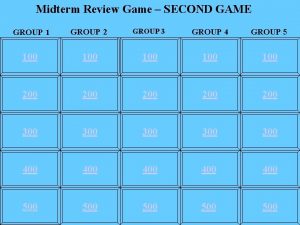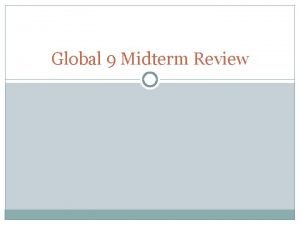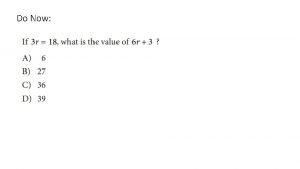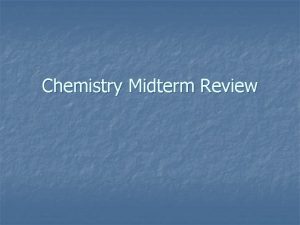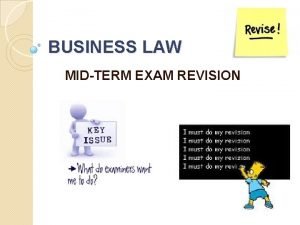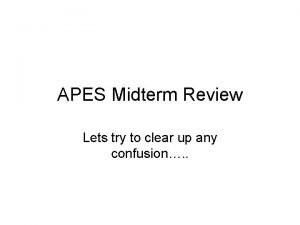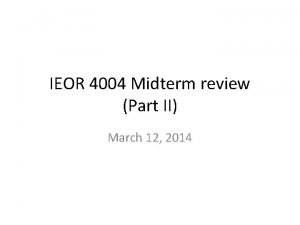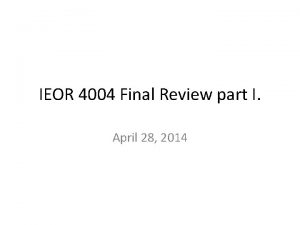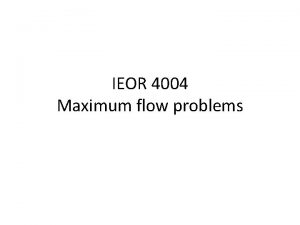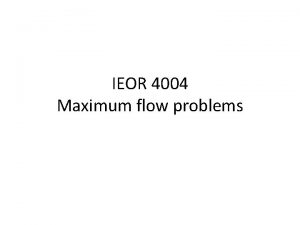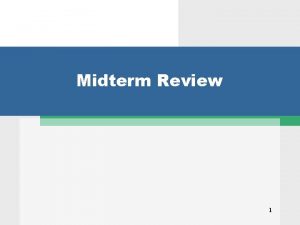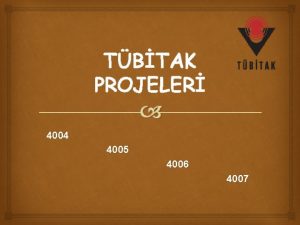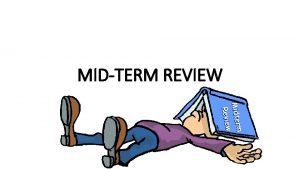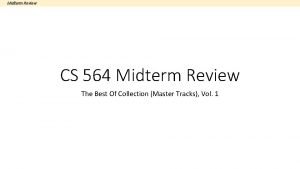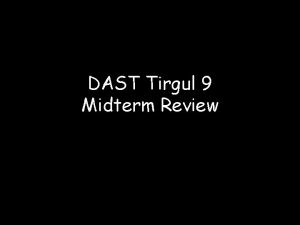IEOR 4004 Midterm Review part I March 10
















- Slides: 16

IEOR 4004 Midterm Review (part I) March 10, 2014

Summary • Modeling optimization problems • Linear program • Simplex method – Algorithm – Initialization – Variants • Sensitivity analysis (in part II) • Duality (in part II) – Upper bounds and Shadow prices – Complementary slackness

Mathematical modeling • Simplified (idealized) formulation • Limitations – Only as good as our assumptions/input data – Cannot make predictions beyond the assumptions We need more maps

Mathematical modeling Problem simplification Model formulation Model Algorithm selection Numeric calculation Problem Interpretation Sensitivity analysis Solution

Mathematical modeling • Deterministic = values known with certainty • Stochastic = involves chance, uncertainty • Linear, non-linear, convex, semi-definite

Formulating an optimization Linear program problem Linear • Decision variables objective • Objective • Constraints • Domains Linear constraints x 1, x 2, x 3, x 4 x 1 Minimize 2 x 2 + 3 x 3 + (1 − 2 x 2)2 (x 1)2 + (x 2)2 + (x 3)2 + (x 4)2 ≤ 2 x 1 − 2 x 2 + x 3 − 3 x 4 ≤ 1 − x 1 + 3 x 2 + 2 x 3 + x 4 ≥ − 2 x 1 x 3 = 1 x 1 ≥ 0 x 2 ≠ 0. 5 x 3 in {0, 1} x 4 in [0, 1] Sign restriction

Linear program • solution = values of variables that together satisfy all constraints {x 1, x 2} x 1 − 2 x 2 + x 3 − 3 x 4 = 1 − x 1 + 3 x 2 + 2 x 3 + x 4 = − 2 x 1 ≥ 0 • • • x 1 = − 1 x 2 = − 1 x 3 = 0 x 4 = 0 x 1 = 4/3 x 2 = 0 x 3 = − 1/3 x 4 = 0 Feasible solution = satisfies also sign constraints Infeasible solution = not feasible Basis = set of m variables (where m = # of equations) Variable in basis = basic variable, all other non-basic Basic solution = set all non-basic variables to zero

Linear program • Feasible region = set of all feasible solutions objective function growth is limited • LP is Infeasible if feasible region empty • LP is Unbounded if the objective function is unbounded over the feasible region objective function grows beyond bounds

Simplex algorithm • Converting to standard form + − 3 x− x 5 = 3 − x 1 + − x+ ’− 34++x 3 x − 3 x + 23 x − x+2’ 432 x − 3 x 4 ≤ x 12 x − x 3 4= 3 54 x 6 = 2 − x 1−+− + ’− 34+2 x 3 x+4+− xx 64− 4≥ x 2+’ 433 x − 22 xx+ 2 x x 13 x + =− 2 z= − 2 x 2 + 3 x’ 3 x 1, x 2 ≥ 0 xx 3’ 3≤ Add slack variables Substitute negative variables Substitute unrestricted variables Dictionary x 5, x 6 ≥ 0 x+4, x− 4 ≥ 0

Simplex method (maximization) START Initial feasible solution Optimality test Are all coefficients in z non-positive ? Alternative solutions? x 5 = 3 − x 1 + 2 x 2 − x’ 3+ 3 x+4 − 3 x− 4 x 6 = 2 − x 1 + 3 x 2 + 2 x’ 3+ x+4 − x− 4 z= − 2 x 2 + 3 x’ 3 xj Pivot xj to the basis Ratio test NO YES optimal solution found Variable selection END xi Find min b/a a = coeff of xi in xj b = value of xj a, b opposite signs xj does not exist LP is unbounded

Simplex algorithm • Anatomy of a dictionary Ratio test: (different sign) basis objective(s) x 5 = 3 − x 1 + 2 x 2 − x 6 = 2 − x 1 + 3 x 2 + z= x 5: 3/1 = 3 x 6: no constraint x’ 3+ 3 x+4 − 3 x− 4 2 x’ 3+ x+4 − x− 4 (same sign) − 2 x 2 + 3 x’ 3 zero negative positive coeff x’ 3 enters x 5 leaves (min ratio)

Simplex/Graphical method • Illustration 150 0 profit: 180 80 max 3 x 13 x +2 x 1 +2 x 2 2 x 1 + x 2 +x 2 x 3≤=80 80 x 1 + 2 x 2 x x 2 + 100 60 x 2 x≤ 100 1 +1 + 4= x 1, xx 2, , xx 3, x≥ 00 4≥ 1 start: x 1=0, x 2=0, x 3=80, x 4=100 x 1 increases until x 4=0 x 2 increases until x 3=0 2 40 z x 1 isoprofit line 3 x 1 +2 x 2 = profit x 3, x 4 are slack variables 20 0 optimal x 3 x 4 x 2 20 40 60 80

Initialization - Phase I • Goal: make all original variables non-basic (=0) • If all-0 doesn’t satisfy a constraint, add artificial variable ai: – add +ai if the right-hand side is > 0 – add –ai if the right-hand side < 0 from equations without artificial variables • Add slack variables (where needed) • New objective: minimize the sum of artificial variables • Starting basis: all artificial + slack variables If optimal value 1 2−−x 3 x 2 x 2 − −x 3 a+ 3 x z = w =s 1 = 2 x Maximize 1+ 3 2 − a 43 x 1 = 5/2 − (7/2)x + (7/4)e + (1/4)a − 3 x (7/4)a − x(5/4)s + (7/4)ethen negative, a 2 x 1=− 3 − 2 (5/4)s − x + 3 x + 2 x + 12− 3 1 2 x + x 1 2 3 4 1 + s 1 =3 1 2 3 4 ≤ x 2 = 0 − −a 3 x 2 x (1/2)s + + (1/2)a −x(1/2)e (1/2)a − 2 x (1/2)s + (1/2)e LP Infeasible = 1 − − x − + e 3− 12+ 3 1 3 + 3 x + 2 x x 2 3 4 3 −− a 22 =− 2 1 2 3 4 = x 4 = 1/2 + (1/2)x 3 + (1/4)s +− 2 x (1/4)e − x(1/4) a 12+ (1/4)a 33 + (1/4)s (1/4)e Else artificial 1 +drop 3 + x ≥ 1 − e = 1 2 3 4 + a 3 − a 2+−xa 1 3− 4 x 2 − 3 x 3 − 3 x 43 − e 3 variables w = − 3 and − 3 x 3 7 x 3 − sa 12+ ea 33 wz = 2 x 2 − − − introduce z

Degeneracy • Basic solution is degenerate if some basic variable is zero – multiple dictionaries max 3 x 1 +2 x 2 x 1 + x 2 + x 3 = 80 2 x 1 + x 2 + + x 4 = 100 6 x 1 + x 2 + +x 5 = 180 x 1, x 2, x 3, x 4, x 5 ≥ 0 x 1 = 20 + x 3 − x 4 x 2 = 60 − 2 x 3 + x 4 x 5 = − 4 x 3 + 5 x 4 z = 180 − x 3 − x 4 optimal x 1 = 20 + 0. 2 x 3 − 0. 2 x 5 x 2 = 60 − 1. 2 x 3 + 0. 2 x 5 x 4 = 0. 8 x 3 + 0. 2 x 5 z = 180 − 1. 8 x 3 − 0. 2 x 5 x 1=20 x 2=60 x 3=x 4=x 5=0 80 60 40 20 20 40 60 80 x 1 = 20 + 0. 25 x 4 − 0. 25 x 5 x 2 = 60 − 1. 5 x 4 + 0. 5 x 5 x 3 = 1. 25 x 4 − 0. 25 x 5 z = 180 − 2. 25 x 4 + 0. 25 x 5 optimal ? ? ?

Upper bounded Simplex • Anatomy of a dictionary Ratio test: (different sign) basis objective(s) bounds x 5 = 3 − x 1 + 2 x 2 − x 3 + 3 x 4 x 6 = 1 − x 1 + 3 x 2 + 2 x 3 + x 4 z= − 2 x 2 + 3 x 3 0 ≤ x 1, x 2 , x 4, x 5 0 ≤ x 3 ≤ 2 0 ≤ x 6 ≤ 4 0 ≤ x’ 6≤ 4 1. (different sign) x 5: 3/1 = 3 2. (entering variable) x 3: 2 3. (same sign) x 6: (4− 1)/2 = 1. 5 (same sign) x 3 enters substitute x 6 = 4 − x’ 6 x 6 leaves (min ratio)

Dual Simplex • Anatomy of a dictionary infeasible! basis objective(s) Ratio test: x 1: no constraint (positive) negative x 2: 5/2 = 2. 5 value x 3: no constraint x 5 = − 3 − x 1 + 2 x 2 − x 3 + 4 x 4 x 4: 7/4 = 1. 75 x 6 = 1 − x 1 + 3 x 2 + 2 x 3 + x 4 z= − 5 x 2 − 3 x 3 − 7 x 4 dually feasible (all coefficients non-positive) x 5 leaves x 4 enters (min ratio)
 Ieor 4004
Ieor 4004 March march dabrowski
March march dabrowski Ieor 130
Ieor 130 Ieor 115
Ieor 115 Ieor 170
Ieor 170 Chapter review motion part a vocabulary review answer key
Chapter review motion part a vocabulary review answer key Michael britt brain mnemonics
Michael britt brain mnemonics Algebra 1 midterm review
Algebra 1 midterm review Whap midterm review
Whap midterm review When backed by buying power wants become
When backed by buying power wants become Global 9 midterm review
Global 9 midterm review Trig midterm review
Trig midterm review Which substance can be decomposed chemically
Which substance can be decomposed chemically Business law midterm review
Business law midterm review Apes midterm review
Apes midterm review Ap chemistry midterm exam
Ap chemistry midterm exam Algebra 2 midterm exam review
Algebra 2 midterm exam review









